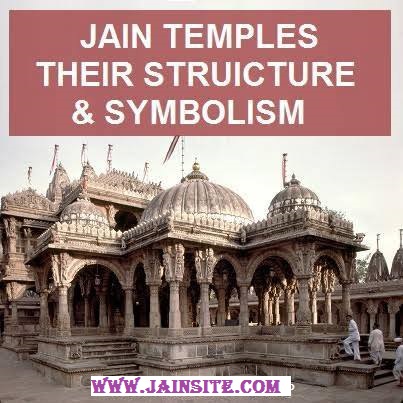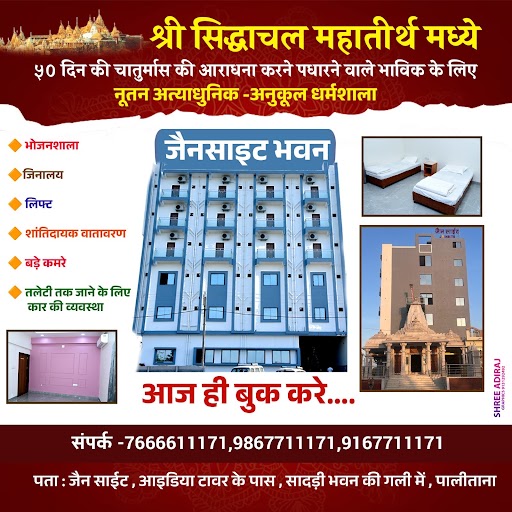
(Arihant Bhagwant ni agya thi)
Although Jain temples frequently share architectural and artistic elements found in temples of other religions, they are distinctively Jain. Their religious buildings are specifically adapted to reflect Jain spiritual ideas and ritual practices.
There are three striking features of Jain religious buildings.
• there is usually more than one shrine in a temple.
• most are surrounded by additional buildings that form part of the religious building.
• temples are frequently clustered together to produce temple complexes or ‘temple-cities’.
PARTS OF A JAIN TEMPLE
The majority of Jain temples in India consist of a few core building elements. Lets understand their function and symbolism. Starting from the outer to the inner –
1. ASPRĀKĀRA – HIGH BOUNDARY WALL
Almost without exception, Jain temples are enclosed by free-standing detached compound walls, encircling the entire sacred temple area.
The symbolism is for the devotee entering to be leave his ordinary concerns of the householder life before entering the holy ground.
2. JAGATĪ OR VEDĪ – PLATFORM
Although may be varied in relative proportions and forms, all Jain temples are built on a platform or terrace that physically raises the temple above the surrounding land and creates a distinct sacred area.
On this pronounced plinth, the temple is protected and appears larger and more monumental. The platforms are often much wider than the actual temple structures and thus provide space for the ritual ambulation –pradakṣiṇā – of the building to take place on the sacred level. This spaciousness also allows further shrines, surrounding the temple building, to be at the same level.
The symbolism is related to the idea of the difficulties –durlābha – in reaching sacred places. By extension it also suggests the long journey to the remote goal of enlightenment.
3. ARDHAMANDAPA – FRONT PORCH
This is the front porch or the main entrance of the temple leading to shrines and maṇḍapas. At the main gateway, a worshiper bends down and touches the threshold before crossing it. The gateway greets the worshiper with a host of sculpted secular figures on the outer walls; representing the worldly concerns of man. Usually the gateway to a temple will be a massive and magnificent construction. When we stand in front our feeling of insignificance helps to break our ego.
The Symbolism is that this marks another transition from the outer world to the inner world of the temple. Porches are very small, simple halls that provide access to.
4. MANDAPA – HALL
This is the hall or halls in front of the garbhagriha, for the assembly of the devotees. The halls can have side walls and be closed or may simply have pillars, which leave the sides open. Temple halls create an approach to the shrine and house more religious statues and ritual equipment. Halls are used for rituals, the recitation of sacred texts, meditation and for larger gatherings that involve singing hymns etc. Here, often the worshiper will come across mythological themes, carved on the inner walls, to attune his attitude towards higher ideals.
The symbolism here is that the devotee must prepare to leave even his concerns for the temple and fellow devottees and prepare to enter the inner sanctum.
5. ANTARĀLA – INTERMEDIATE CHAMBER
Some temples have this additional element. This small vestibule is a space between the main sanctuary and its hall, in which worshippers can stand and gaze at the idol or follow rituals conducted within the shrine. As the worshiper progresses towards the inner sanctum, the sculptural details and decorations become simpler.
The symbolism is again to help the worshiper to put aside distractions and try focusing their attention on the sanctum.
6. PRADAKSHINA PATHA – CIRCUMAMBULATION PASSAGEWAY
It consists of enclosed corridor carried around the outside of garbhagriha. The devotees walk around the deity in clockwise direction as a worship ritual and symbol of respect to the temple god or goddess.
The symbolism here is that this represents an encircling of the universe itself.
7. SHIKHARA – TOWER or SPIRE
The upper part of the Garbh griha is called as the Sikhara; the pyramidal or tapering portion of the temple, Vastu Shastra says that the design of the Shikhara over the Garbhagrahamm attracts energies from the cosmos from the cosmos, much like an aerial or even like our nose attracts pranavayu (oxygen) from air.
The symbolism here that it represents the axis of the world through Mount Meru.
8. GAMBHARA – INNER SANCTUM
The main part of Jain temple is called “Gambhara” (Garbha Graha) which is the nucleus and the innermost chamber of the temple where the image or idol of the main deity (mulnayak) is placed.
This is the focal point of the building and beside a statue of a sacred figure it may house abstract religious element, such as the eight auspicious symbols, the siddhacakra, the cosmic person, yantras and sacred syllables or mantras. The shrine or garbha-griha (womb space) is usually devoid of any ornamentation to avoid distraction and lead the worshiper further to tranquility.
The Symbolism here is in the name – garbha = womd, graha = home; representing the final journey of the soul to its real self.
The walk to the inner sanctum indicates that we have to leave the grand external world outside and direct our minds inward, light up the lamp of knowledge there and by seeing the Jina we are to behold our Atma within the sanctum sanctorum of our hearts.
Thus the ideology behind the designing of Jain temples is to link man with himself. It is a depiction of the macrocosm (the universe) as well as the microcosm (the inner space) and has developed over thousands of years. According to the Jaina ethics, a man’s life is asummation of countless individual lifespans bound up in the cycle of rebirth. One can from achieve enlightenment thorough pure deeds, thoughts and dedication. Thus, in this world the temple is the symbol of enlightenment: it is the place where we can be closer to our soul and through rituals and ceremonies men can discover the divine knowledge.
Michämi Dukaddam (apologies) for any errors and omissions. Data compiled from many Web sites Jain, Lectures & Books. Image sourced from the online web. Shäshan Viruddha Känay Lakhäyu hoy to Man, Vachan and Kaya Thi Micchhämi Dukkadam.


